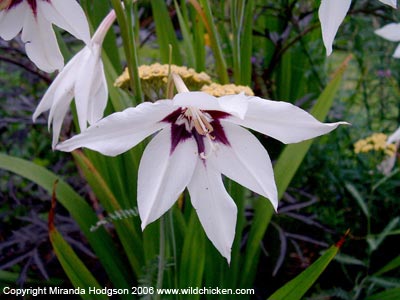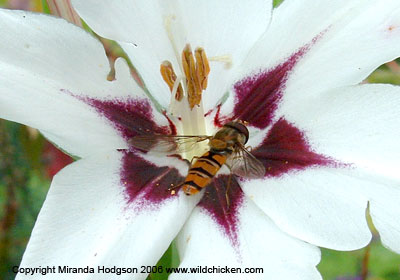


Gladiolus murielae (also called Gladiolus callianthus 'Murielae', Acidanthera murielae,
Acidanthera bicolor 'Murielae' and Abyssinian gladiolus)
Gladiolus
murielae
Slightly tender cormous perennial with sword-like, upright green leaves. Each stem bears several fragrant white flowers, marked with dark purple at the centre. Good for cottage and mixed and flower borders. Also good for cutting.
It's personal, but I think this plant looks very good growing close to Sambucus nigra 'Black Lace' - the dark colouring at the centre of each flower complements that of the Sambucus foliage. Add in something a bit brighter, as contrast, for a lovely display. I chose Achillea 'Walter Funke' and was very pleased with the effect.
Attractive to hoverflies and other beneficial insects.
Flowers in summer.
Habit - straight, upright. H: 1m S: 10cm
Stems - straight, smooth, mid-green.
Leaves - straight, sword-like, mid-green.
Flowers - borne in mid to late summer. Each stem bears a number of flowers which open in succession. They are scented, trumpet-shaped, with six pointed-oval, white petals, each with a dark purple smudge at the base. The pronounced stamens hold much pollen, making the flower attractive to some beneficial insects.
South, east or west, Warm, sunny and sheltered.
Not fussy as far as acidity/alkalinity goes. Likes soil to be moist but well-drained or well-drained.
Not hardy in most UK winters.
Pruning not necessary. Wait until the foliage has died down in late autumn and then lift the corms and store them for winter, replanting in spring.
In years where the summer is wet or cold, the corms may not build up enough reserves to flower the following summer and, because of this, some people prefer to buy fresh corms each year. You can also lift them, pot them up and store them in a frost free place till spring.
In mild areas of the UK, a thick mulch over the plants may protect them throughout the winter.
Susceptible to thrips, aphids slugs, grey moulds and gladiolus corm rot. This sounds like a long list of possible problems, but doesn't mean that they'll all happen, if any. None of them have been noticed on my plants this year.
Separate off the small new corms (cormlets) and replant.
Garden Plant Information list of plant care info by botanical name